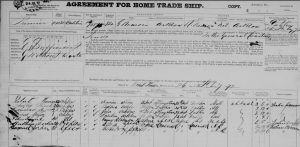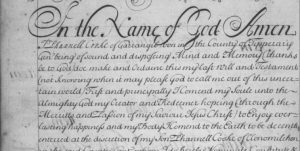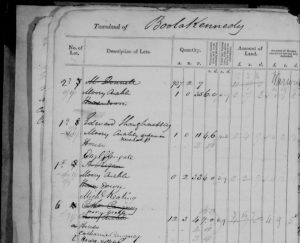This is ridiculous. First, the Department of Arts, Heritage and the Gaeltacht releases probably the most significant batch of Irish genealogical records ever seen online. Then, just a week later, the National Archives sees the Department’s bet and raises it by the entire pot. Six separate record collections, each of which alone would be a major gift to researchers have been published at once.
To go through them:
-

The crew’s list for the Premier, sailing out of Arklow in 1872 There are 536,413 individual records between 1860 and 1921 in the Crews and Shipping lists. They cover very port now in the Republic: a godsend for anyone with mariners in their tree.
- The Catholic Qualification & Convert Rolls comprise two similar but distinct sources. The Convert Rolls list 5,866 people who converted from Catholicism to the Church of Ireland between 1703 and 1838. The much larger Catholic Qualification Rolls record 45,722 individuals who remained Catholic but took an oath of allegiance to the Crown in order to avail of rights newly restored under late 18th-century Catholic Relief Acts. They date from 1788 to 1845. I suspect many of both groups had their fingers crossed behind their backs.

- Almost all of the old Public Record Office’s pre-1858 collection of official probate records was destroyed in 1922. All the bits and pieces that happened to be outside the Record

The 1707 prerogative will of Pharrell Cooke of Garrangibbon, Tipperary Treasury when it was pulverised are now on the site, covering 15,560 individuals. There are plenty of other, non-official, testamentary sources, but these are wonderful.
- The collection of marriage licences 1623-1866 records 217,850 individuals, almost all in marriages that were in destroyed Church of Ireland parish registers.
- After 1858, district probate offices made copies of all the wills they probated before sending the originals to the PRO. So, although the originals were destroyed, there are 179,048 copies, now fully imaged and searchable.
- And most significant of all are the 1,366,275 Valuation Office records. These are the notebooks used by the VO’s army of valuers and surveyors to create Griffith’s

Evictees from Boolakennedy townland in 1847 Valuation. They predate Griffith by anything up to twenty years, at a period when the country was going through the massive upheaval of the Famine. In the hardest hit areas, they can reveal entire villages that had been wiped out by the time the full Valuation was published.
Marvellous. But there’s a bit of fatigue setting in. What’s next? The government handing everyone of Irish descent a personalised 10-generation parchment pedigree?

Agreed. A fantastic couple of weeks for Irish genealogy. I was particularly looking forward to the release of the Valuation books, hoping that it would reveal a bit more on my Rolston ancestors in west Co. Sligo. However, there were only Field books released for some parishes and none at all for other parishes but I guess it’s just the luck of the draw really but I believe that there are still quite a number of these books not digitised yet, and will be eventually put online. I’ll keep my fingers and toes crossed!
Such a fantastic opportunity for Irish researchers…I just need more time at home 😉
AMEN…or should it be AH…John?
WOW..I would really LOVE that Personalized 10 generation PARCHMENT PEDIGREE…?????????.. Seriously I am new to Geneology and am looking forward to these new research options..
Great stuff, getting time to go through so much and digesting the information , wow.
It’s been a stunning few weeks for everybody interested in Irish genealogy – hopefully nobody tells the Data Commissioners about the Civil Records now available on irishgenealogy.ie !!
They’ve already caused the removal of Prison Registers from familysearch.org and the Voters Lists from the Dublin City Library website – how long will it be before they target the GRO indexes on familysearch.org ?
Who are the Data Commissioners and why do they have this power?
I am looking forward to the canceled rent books – post Griffiths valuation books.
Who needs sleep anyway? Thanks for collecting them all in one place..
I’ve hardly slept! Fascinating.
Please don’t knock it as we have been waiting for over ten years for releases such as these to assist us with our research.
When you live on the other side of the world and do not have these repositories on your doorstep they are a god-send for all those researching Irish who cannot afford to take a trip to Ireland.
These are free to search also for which we can all be thankful.
Thanks. Love your summary and appreciate your enthusiasm. I’ve just started looking at my Irish ancestors, even though the Irish influences were a much more dominant force in my childhood than the Scottish and Danish (yes: the wakes and gatherings of the 1950s are a strong memory). I’ve left them until last because I thought I knew about them, “free settlers all” according to my grannie and her siblings. Wrong. Their grandparents were both convicts (James Roach and Ann Mc Donagh). So these releases are wonderful for me. Thanks for making their content easily understood. And thanks for your posts. I love reading them.
The Wills are an interesting window into the lives of Irish people. I’ll be dipping in and out of them. One I read the other day gave instruction that there was to be no drinking at the Wake. Our ancestors liked a drink but there were also campaigns to discourage drinking alcohol because of the damage it did to families.
A question about interpreting the valuation books; my gg-grandfather Daniel Ahern (Cork/Ballyhooly/Gortroche). There is an entry in very dark ink, and then 2 more below in a lighter ink (perhaps made later), and then the whole lot is struck through and marked “Down” in large letters. How to interpret?
The revision books were colour coded, each year the valuator, or person in the Valuation Office, used a different ink. Eventually they followed a pattern (so that 1877,87,97 and so forth should be the same colour, but in the early decades, they appear to be random.
Again, with experience, they showed the colour code at the front of the book, but this was slow to catch on, some were better than others.
Your dark ink may be black, the lighter ink may be red or green.
Incidentally, the reason I say a person in the VO rather than the valuator, is because the valuator travelling around on horseback, would have found it difficult to open his inkwell in some muddy field, so often wrote provisionally in pencil. We often see pencil under the ink.
When I first started researching my husband’s Mayo ancestors and my County Kerry ancestors (in 2002 from here in Ohio) it was almost impossible to find anything useful. Eventually you could get transcribed information at an extremely high price. Unfortunately I am going somewhat insane compulsively searching, esp. these Civil Registration records. I was especially amazed to find a Willis family will that cleared up some confusion.